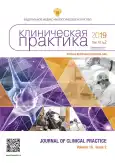Surgical methods of treatment of Eagle syndrome
- Authors: Nazaryan D.N.1, Karayan A.S.1, Fedosov A.V.1
-
Affiliations:
- Clinical Centre of Otorhinolaryngology of Federal Medical Biological Agency of Russia
- Issue: Vol 10, No 2 (2019)
- Pages: 21-26
- Section: Original Study Articles
- URL: https://journals.rcsi.science/clinpractice/article/view/13453
- DOI: https://doi.org/10.17816/clinpract10221-26
- ID: 13453
Cite item
Full Text
Abstract
Background. One of the most difficult in the clinical practice patients groups are patients with orofacial pain. A possible cause of pain in the face and mouth can be stylohyoid syndrome or Eagle syndrome. The clinical manifestations of the syndrome are observed in only 4-10.3% of cases among the total number of cases of elongated hyoid processes.
Objective. To develop criteria for the choice of the surgical access for a safe removal of the hyoid process depending on its anatomy.
Methods. In patients with the symptoms of stylohyoid syndrome, in the case of detecting an extended hyoid process during the clinical study, its removal was performed via an intraoral route (n=3). In the other patients (n=10) the removal was performed via an external access along the first cervical fold, or through the vertical retroaural access.
Results. In patients with stylohyoid syndrome, we observed a high efficiency of the surgical treatment and rather short times of postsurgical rehabilitation, that significantly improved the quality of life.
Conclusion. In our opinion, the surgical access through the first cervical fold is the most convenient way both from the technical viewpoint and from the viewpoint of a minimal cosmetic defect.
Full Text
##article.viewOnOriginalSite##About the authors
D. N. Nazaryan
Clinical Centre of Otorhinolaryngology of Federal Medical Biological Agency of Russia
Author for correspondence.
Email: craniofacial@yandex.ru
ORCID iD: 0000-0001-9423-2221
канд. мед. наук, врач челюстно-лицевой хирург, зав. отделением челюстно-лицевой и пластической хирургии
Russian Federation, MoscowA. S. Karayan
Clinical Centre of Otorhinolaryngology of Federal Medical Biological Agency of Russia
Email: craniofacial@yandex.ru
ORCID iD: 0000-0002-3608-4854
д-р мед. наук, врач челюстно-лицевой хирург, руководитель отдела челюстно-лицевой и пластической хирургии
Russian Federation, MoscowA. V. Fedosov
Clinical Centre of Otorhinolaryngology of Federal Medical Biological Agency of Russia
Email: dr.fedosov@mail.ru
ORCID iD: 0000-0002-4372-7723
врач челюстно-лицевой хирург, руководитель отделения челюстно-лицевой и пластической хирургии
Russian Federation, МоскваReferences
- Eagle WW. Elongated styloid processes: report of two ca-ses. Arch. Otolaryngol. Head and Neck Surgery. 1937;25(5):584-587. doi: 10.1001/archotol. 1937.00650010656008.
- Шульга И.А., Лебедянцев В.В., Каган И.И., и др. Факторы патогенеза шилоподъязычного синдрома // Российская оториноларингология. — 2011. — №4. — С. 175-182. [Shulga IA, Lebedyantsev VV, Kagan II, et al. Factors of pathogenesis of stylohyoid syndrome. Russian otorhinolaryngology. 2011;(4):175182. (In Russ).]
- Лебедянцев В.В. Шилоподъязычный синдром: топографо-анатомические основы, клиника, диагностика, принципы лечения: Автореф. дис. … д-ра мед. наук. — М., 2004. — 44 с. [Lebedyantsev V.V. Shilopod’’yazychnyj sindrom: topografo-anatomicheskie osnovy, klinika, diagnostika, printsipy lecheniya. [dissertation abstract] Moscow; 2004. 44 р. (In Russ).] Доступно по: https://search.rsl.ru/ru/record/01002800036. Ссылка активна на 14.02.2019.
- Барабанова Э.В., Сытый Ю.В. Роль шило-каротидного синдрома в развитии диссекции внутренней сонной артерии и инфаркта мозга (обзор литературы, собственное наблюдение) // Международный неврологический журнал. — 2017. — №5. — С. 38-45. [Barabanova EV, Syty YuV. The role of stylo-carotid syndrome in the development of dissection of the internal carotid arteryand cerebral infarction (a literature review and own observation). INJ. 2017;(5):38-45. (In Russ).] doi: 10.22141/2224-0713.5.91.2017.110855.
- Murtagh RD, Caracciolo JT, Fernandez G. CT findings associated with Eagle syndrome. AJNR Am J Neuroradiol. 2001;22(7):1401-1402.
- Ghosh LM, Dubey SP. The syndrome of elongated styloid process. Auris Nasus Larynx. 1999;26(2):169-175. doi: 10.1016/s0385-8146(98)00079-0.
Supplementary files













